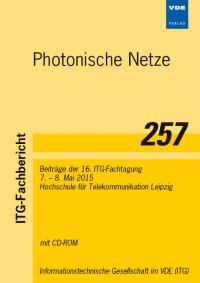A Transport-SDN application for incremental on-line network optimization
Konferenz: Photonische Netze - 16. ITG-Fachtagung
07.05.2015 - 08.05.2015 in Leipzig, Deutschland
Tagungsband: Photonische Netze
Seiten: 4Sprache: EnglischTyp: PDF
Persönliche VDE-Mitglieder erhalten auf diesen Artikel 10% Rabatt
Autoren:
Ilchmann, I.; Dembeck, L.; Milbrandt, J. (Alcatel-Lucent Deutschland AG, Bell Labs Germany, Lorenzstr. 10, 70435 Stuttgart, Germany)
Inhalt:
Today, off-line network planning tools are used to optimize transport networks from scratch. A set of pre-planned wavelength services is taken into account for routing optimization. Performing such optimization in an operational transport network may lead to the rerouting of a large amount of wavelengths per link followed by massive adjustments of optical power levels. Hence, an approach is needed that performs on-line optimization of an operational network in a continuous and incremental way, thus enabling a smooth migration towards always optimal routing. To implement such an optimization application, which is also vendor-independent, an open control framework like Transport - Software Defined Networking (T-SDN) is particularly suitable. Our T-SDN optimization application presented here runs on top of a SDN controller which - in turn - is communicating with the network elements. A demonstration environment has been developed to evaluate feasibility and benefits of such on-line network optimization. Beside the application, the demonstrator comprises an Alcatel-Lucent Proof-of-Concept T-SDN controller as well as an emulated transport network based on the Alcatel-Lucent 1830 Photonic Service Switch (PSS). For ease of demonstration, the current network topology and configuration are query results from the SDN controller and thus input parameters for our application. The application performs a continuous routing optimization which is aware of physical impairments of optical transmission. The goal of this incremental optimization process is to affect only a very small number of wavelengths per iteration thus limiting the impact of wavelength rerouting on the photonic layer. The process itself can either be controlled by the network operator or can be run periodically in background to determine inefficient routes and to find better alternatives. If a more efficient route was found, the new path information is posted to the SDN controller which has to implement the rerouting. Our application thus enables the permanent analysis of lightpath deployment in transport networks in order to increase resource utilization and reduce cost per service.


